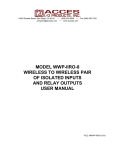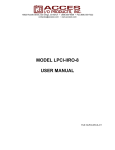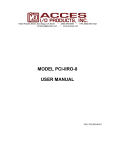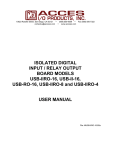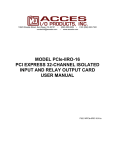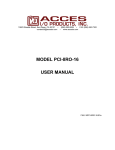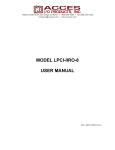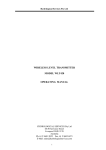Download Acces WM-IIRO-8 User manual
Transcript
10623 Roselle Street, San Diego, CA 92121 y (858) 550-9559 y Fax (858) 550-7322 [email protected] y www.accesio.com MODEL WWP-IIRO-8 WIRELESS TO WIRELESS PAIR OF ISOLATED INPUTS AND RELAY OUTPUTS USER MANUAL FILE: MWWP-IIRO-8.A2c Notice The information in this document is provided for reference only. ACCES does not assume any liability arising out of the application or use of the information or products described herein. This document may contain or reference information and products protected by copyrights or patents and does not convey any license under the patent rights of ACCES, nor the rights of others. IBM PC, PC/XT, and PC/AT are registered trademarks of the International Business Machines Corporation. Printed in USA. Copyright 2007 by ACCES I/O Products, Inc. 10623 Roselle Street, San Diego, CA 92121. All rights reserved. WARNING!! ALWAYS CONNECT AND DISCONNECT YOUR FIELD CABLING WITH THE COMPUTER POWER OFF. ALWAYS TURN COMPUTER POWER OFF BEFORE INSTALLING A BOARD, CONNECTING AND DISCONNECTING CABLES, OR INSTALLING BOARDS INTO A SYSTEM WITH THE COMPUTER OR FIELD POWER ON MAY CAUSE DAMAGE TO THE I/O BOARD AND WILL VOID ALL WARRANTIES, IMPLIED OR EXPRESSED. 2 Manual WWP-IIRO-8 Warranty Prior to shipment, ACCES equipment is thoroughly inspected and tested to applicable specifications. However, should equipment failure occur, ACCES assures its customers that prompt service and support will be available. All equipment originally manufactured by ACCES which is found to be defective will be repaired or replaced subject to the following considerations. Terms and Conditions If a unit is suspected of failure, contact ACCES' Customer Service department. Be prepared to give the unit model number, serial number, and a description of the failure symptom(s). We may suggest some simple tests to confirm the failure. We will assign a Return Material Authorization (RMA) number which must appear on the outer label of the return package. All units/components should be properly packed for handling and returned with freight prepaid to the ACCES designated Service Center, and will be returned to the customer's/user's site freight prepaid and invoiced. Coverage First Three Years: Returned unit/part will be repaired and/or replaced at ACCES option with no charge for labor or parts not excluded by warranty. Warranty commences with equipment shipment. Following Years: Throughout your equipment's lifetime, ACCES stands ready to provide on-site or in-plant service at reasonable rates similar to those of other manufacturers in the industry. Equipment Not Manufactured by ACCES Equipment provided but not manufactured by ACCES is warranted and will be repaired according to the terms and conditions of the respective equipment manufacturer's warranty. General Under this Warranty, liability of ACCES is limited to replacing, repairing or issuing credit (at ACCES discretion) for any products which are proved to be defective during the warranty period. In no case is ACCES liable for consequential or special damage arriving from use or misuse of our product. The customer is responsible for all charges caused by modifications or additions to ACCES equipment not approved in writing by ACCES or, if in ACCES opinion the equipment has been subjected to abnormal use. "Abnormal use" for purposes of this warranty is defined as any use to which the equipment is exposed other than that use specified or intended as evidenced by purchase or sales representation. Other than the above, no other warranty, expressed or implied, shall apply to any and all such equipment furnished or sold by ACCES. 3 Manual WWP-IIRO-8 Table of Contents Chapter 1: Introduction ...........................................................................................................................5 Features ...................................................................................................................................................5 Applications............................................................................................................................................5 Functional Description ........................................................................................................................5 Figure 1-1: Block Diagram Depicting One-Way Signal Flow .................................................6 Figure 1-2: Block Diagram Depicting Two-Way (Pair of Units) Signal Flow .....................7 Ordering Guide ......................................................................................................................................8 Included with your board ....................................................................................................................8 Optional Accessories...........................................................................................................................8 Chapter 2: Installation..............................................................................................................................9 Figure 2-1: Module with the lid open and terminal blocks identified ..................................9 Power........................................................................................................................................................9 Antenna Installation ...........................................................................................................................10 Test Setups ...........................................................................................................................................10 Bare Minimum Test.........................................................................................................................10 Medium Scale Test..........................................................................................................................10 Thorough Scale Test ......................................................................................................................10 Verify Wireless Connection..............................................................................................................10 Figure 2-2: Input terminal block signal connection locations ............................................11 Figure 2-3: Relay terminal block signal arrangements .........................................................11 Chapter 3: Hardware Details ................................................................................................................12 Option Selections................................................................................................................................12 Filter Response Jumpers ..................................................................................................................12 Figure 3-1: Option Selection Map ...................................................................................................12 Table 3-1: Input Filter Jumper Selections.....................................................................................12 Chapter 4: Connector Pin Assignments ...........................................................................................13 Table 4-1: Screw Terminal Connections .......................................................................................13 Chapter 5: Specifications......................................................................................................................14 General...................................................................................................................................................14 Power Requirements ..........................................................................................................................14 900 MHz Radio .....................................................................................................................................14 900 MHz Antenna.................................................................................................................................14 Isolated Inputs .....................................................................................................................................14 Relay Outputs.......................................................................................................................................15 Environmental ......................................................................................................................................15 Customer Comments .............................................................................................................................16 4 Manual WWP-IIRO-8 Chapter 1: Introduction Features • Wireless Digital Input / Relay Output Module Pair • Each input on one unit is mapped to control the corresponding relay automatically in the other • 7-mile line of site communications over integrated non-licensed FCC radio modems • Removable omni-directional antenna without requiring access to inside of enclosure • 900 MHz unlicensed radio modem with frequency hopping spread spectrum technology • NEMA4 enclosure for harsh atmospheric or marine environments • Two water-tight cable glands for power and I/O field wiring • Inputs accept from 3 to 33V (DC or AC rms) as an “on” signal • Relays can switch up to 60 VDC and up to 125 VAC • Switching current capability up to 0.5 A at 125 VAC; 1 A at 24 VDC • Auto-detection seeks for communications from each other when power applied Each unit in the pair has the following • 8 optically-isolated, non-polarized digital inputs • Jumper-selectable filters per input for electrically noisy environments • 8 SPDT electromechanical relay outputs • Internal removable screw terminal boards for simplified wiring Applications • Factory Automation • Energy Management and Conservation • Agricultural and Irrigation Systems • Security • Refinery • Marinas and Ports • Lighting • Traffic and Mobile Functional Description This product features a pair of intelligent 8-bit parallel digital I/O units that communicate with each other without requiring a connection to a PC. When an input is turned on at one of the units, it will cause the corresponding relay to switch on the other unit. As long as the input stays active, the corresponding relay will remain energized on the other unit. If power is lost to either unit, the other unit will retain the last valid commanded position for the relays. When power is restored to the first unit, any changes that occurred to the eight inputs would then be communicated to the unit that didn’t lose power, and the relays would follow the newly reported state. 5 Manual WWP-IIRO-8 The units are packaged in NEMA4 enclosures for remote installation in harsh environments. These units act wirelessly, saving time and money associated with wired installations. The units can work at various distances up to 7 miles with the standard antenna shipped with the product. Alternate antennas may be used to boost signal strength. The 8 isolated inputs can be driven by either AC or DC signals and are not polarity sensitive. Input signals are rectified by photocoupler diodes. Standard 12/24 AC control transformer outputs can be accepted as well as DC voltages. The input voltage range is 3 to 28 volts (rms). Unused power dissipates through a 1.8KΩ resistor. External resistors connected in series with this may be used to extend the input voltage range. Each input circuit contains a switchable slow/fast filter that has a 4.7 ms time constant. (Without filtering, the response is 10 μs) The filter must be selected for AC inputs in order to eliminate response to zero crossings, however, it is also valuable for use with slow DC signals in a noisy environment. A filter is individually selected when a jumper is installed onto any of the positions ‘FILTER 0' thru ‘FILTER 7'. A built-in watchdog timer resets the unit if the microcontroller "hangs up". Figure 1-1: Block Diagram Depicting One-Way Signal Flow 6 Manual WWP-IIRO-8 Figure 1-2: Block Diagram Depicting Two-Way (Pair of Units) Signal Flow 7 Manual WWP-IIRO-8 Ordering Guide WWP-IIRO-8 WWP-II-8/RO-8 Pair of WWM-IIRO-8's (8 Inputs / 8 Relays, x2) One WWM-II-8 paired with one WWM-RO-8 (8 Inputs / 8 Relays) Model Options -OEM Boards only (no enclosure) -HG High gain antenna – -24 2.4GHz wireless module Included with your board The following components are included with your shipment, depending on options ordered. Please take the time now to ensure that no items are damaged or missing. • • • • Pair of wireless modules in NEMA4 enclosures Pair of removable directional antennas Printed WWP Quickstart Guide ACCES I/O Master CD (install package for utilities and PDF user manual) Optional Accessories PWR-ACDC-12V “Wall wart” power supply120VAC to 12VDC with 6’ cable. Stripped and tinned wire termination ready for connection to internal screw terminals WM-9-DP-485 900MHz Wireless serial modem with di-pole antenna for connection to an RS-485 port, for monitoring and logging messaging between WWP-IIRO-8 units USB-485 USB to RS-485 converter for DB9 connection to WM-9-DB-485 for monitoring and logging messaging between WWPIIRO-8 units 8 Manual WWP-IIRO-8 Chapter 2: Installation Prior to installing the pair into their final locations, it is recommended you bench test the units side by side to become familiar with their response times, major features and I/O interfaces. Gain access to the inside of the enclosure by removing the four lid screws, then set the lid and these screws aside. This is what you should see: Figure 2-1: Module with the lid open and terminal blocks identified Power If you ordered two of the optional accessory PWR-ACDC-12V along with the WWP-IIRO-8, they ship pre-wired into the appropriate screw terminals. If you didn’t order the optional power supply, you’ll need to provide a DC power source between 7.5V and 15V. Carefully pull up on the input removable screw terminal board to remove it. Route your power supply wires through the gland on the right and make the connections referring to the connector pin assignments in Chapter 5. 9 Manual WWP-IIRO-8 Antenna Installation Screw the directional antenna onto the coaxial connector on the side of the enclosure until it is snug. Screw the second antenna onto the second unit. Test Setups There are three scales of test setups from basic to thorough. Bare Minimum Test Simply apply power to both units and observe the red RX LED in each unit. If both RX LEDs are blinking, the units are communicating with each other. Medium Scale Test This test should consist of a means to control (switch) power to each input independently, thereby providing a means to switch each relay in the other unit. One way to perform this test would be to have eight twisted pairs of wire at least 12 inches with each wire end stripped, then connect each twisted pair to an input. Tighten each screw terminal down onto the stripped wire end until all eight connections are completed, then route the twisted pair bundle through the gland. Re-install the removable terminal block onto the input header. Apply power to both units, then apply a voltage to each input pair one at a time and listen for the relays in the other unit to click, following the input status of the first unit. Thorough Scale Test Using an I/O utility accessory with switches, screw terminals and LEDs such as the TAD8-16, you could wire up the power supply return to the “B” side of each input, and the power supply positive to one side of each switch. Connect the other side of each of the eight switches to the “A” side of each input. Then wire the power supply return to the cathode of each of the eight LEDs and connect the power supply positive to the common “C” terminal of each relay. As a final set of connections for the first unit, connect the normally open “NO” contact terminal of each relay to the anode of each LED on the accessory board. On the second unit, wire up the terminal boards with the power supply positive at each relay common and the power supply return to each “B” input. Then make a one-to-one connection between each NO relay contact and each “A” input. Power on both units and toggle each switch to perform a “round-trip” test. Each switch that gets toggled into the first unit should control the corresponding relay in the second unit. When the relay in the second unit switches, it will switch power to the input of the second unit, which will then switch the corresponding relay in the first unit. Verify Wireless Connection Make sure that the green LED is illuminated and that the red LED is blinking in each unit. The signal strength of the antenna can be affected by various things. If possible, mount the units as high as possible within line of sight. If the signal passes from building to building, installing the units near a window can help maintain signal strength. High gain antennas are also available which can increase the gain up to 11dBi. Consult factory. 10 Manual WWP-IIRO-8 Input and Relay Connections Route all input wiring through the same gland that you routed power. Route all output wiring through the other gland. Make connections per the connector pin assignment table in Chapter 5. Signal arrangements are intuitive on the removable terminal blocks. Figure 2-2: Input terminal block signal connection locations Figure 2-3: Relay terminal block signal arrangements 11 Manual WWP-IIRO-8 Chapter 3: Hardware Details Option Selections Filter Response Jumpers Jumpers are used to select input filtering on a channel-by-channel basis. When jumper FLT0 is installed, additional filtering is introduced for input bit 0, FLT1 for bit 1, etc. This additional filtering must be used when AC inputs are applied. Figure 3-1: Option Selection Map JUMPER SELECTION Bit Filtered FLT-0 FLT-1 FLT-2 FLT-3 FLT-4 FLT-5 FLT-6 FLT-7 IN00 IN01 IN02 IN03 IN04 IN05 IN06 IN07 Table 3-1: Input Filter Jumper Selections 12 Manual WWP-IIRO-8 Chapter 4: Connector Pin Assignments ‘Isolated Input’ Terminal Block PCB Signal ‘Relay Output’ Terminal Block PCB Signal 1 GND 1 Relay 7 - normally closed 2 GND 2 Relay 7 - common 3 +PWR* 3 Relay 7 - normally open 4 +PWR* 4 Relay 6 - normally closed 5 N/C 5 Relay 6 - common 6 N/C 6 Relay 6 - normally open 7 N/C 7 Relay 5 - normally closed 8 N/C 8 Relay 5 - common 9 N/C 9 Relay 5 - normally open 10 N/C 10 Relay 4 - normally closed 11 Isolated Input 7 B 11 Relay 4 - common 12 Isolated Input 7 A 12 Relay 4 - normally open 13 Isolated Input 6 B 13 N/C 14 Isolated Input 6 A 14 N/C 15 Isolated Input 5 B 15 Relay 3 - normally closed 16 Isolated Input 5 A 16 Relay 3 - common 17 Isolated Input 4 B 17 Relay 3 - normally open 18 Isolated Input 4 A 18 Relay 2 - normally closed 19 Isolated Input 3 B 19 Relay 2 - common 20 Isolated Input 3 A 20 Relay 2 - normally open 21 Isolated Input 2 B 21 Relay 1 - normally closed 22 Isolated Input 2 A 22 Relay 1 - common 23 Isolated Input 1 B 23 Relay 1 - normally open 24 Isolated Input 1 A 24 Relay 0 - normally closed 25 Isolated Input 0 B 25 Relay 0 - common 26 Isolated Input 0 A 26 Relay 0 - normally open Table 4-1: Screw Terminal Connections 13 Manual WWP-IIRO-8 Chapter 5: Specifications General • Intelligence: Type 8051 microcontroller family provides capability of local control • Protection: Watchdog Timer circuit • Size of NEMA4 box: 4.53" long by 3.54" wide by 2.17" high • Weight: 19.0 oz Power Requirements • Voltage Range: 7.5 to 16 volts • Current Range: 130 mA - idle mode 30 mA - increase per relay activation 100 mA - increase during constant transmission 470 mA - maximum Idle mode may be reduced to 70 mA with cyclic sleep mode 900 MHz Radio • Frequency Range: 902 to 928 MHz, Unlicensed ISM Band • Type: Frequency Hopping Spread Spectrum Transceiver • Transmit Power: 100mW • Receiver Sensitivity: -110dBm • Outdoor Range: 7 miles (theoretical with line of sight) • Interference Rejection: 70dB at pager and cellular phone frequencies 900 MHz Antenna • Frequency Range: 902 to 928 MHz • Impedance: 50 Ω nominal • Gain: 2.1 dBi • Length: 7" • Polarization: Vertical • Wave: Half Wave • Connector: SMA reverse polarity plug (RPSMA) Isolated Inputs • Number: Eight • Type: Non-polarized, optically isolated from each other and from the computer (CMOS compatible) • Logic Input Low: -0.5 V to 0.8 V • Logic Input High: +3.0 V to +33.0 V • Isolation: 60V channel-to-ground or channel-to-channel • Input Resistance: 1.8K ohms in series with two diodes and an LED • Change of State Detection: Change-of-state flags can be set on either the rising or falling edge of any enabled input bit and can be read via the serial port 14 Manual WWP-IIRO-8 Relay Outputs • Number: Eight • Contact Form: SPDT (form C) • Contact Type: Single Crossbar • Contact Material: Silver + Gold-clad • Rated Load: 0.5 A at 125 VAC; 1 A at 24 VDC • Max. Switching Current: 1A • Max. Switching Voltage: 125 VAC; 60 VDC • Max. Switching Capacity: 62.5 VA; 30 W • Contact Resistance: 100 mΩ max. • Operate Time: 5 ms • Release Time: 5 ms • Contact Life (mechanical): 5 million operations Environmental • Operating Temperature Range: 0°C to 65°C • Temperature De-rating: Based on the power applied, maximum operating temperature may have to be de-rated because internal power regulators dissipate some heat. For example, when 7.5VDC is applied, the temperature rise inside the enclosure is 7.3°C above the ambient temperature. Maximum operating temperature can be determined according to the following equation: VI(TJ = 100) < 19.6 - TA/6.83 Where TA is the ambient temperature in °C. and VI(TJ = 100) is the voltage at which the integral voltage regulator junction temperature will rise to a temperature of 100 °C. (Note: The junction temperature is rated to 120 °C. maximum.) For example, at an ambient temperature of 25 °C., the voltage VI can be up to 15.9V. At an ambient temperature of 100°F (37.8°C), the voltage VI can be up to 14V. • Storage Temperature Range: -20 °C. to +70 °C. • Humidity: 5% to 95% RH non-condensing. 15 Manual WWP-IIRO-8 Customer Comments If you experience any problems with this manual or just want to give us some feedback, please email us at: [email protected]. Please detail any errors you find and include your mailing address so that we can send you any manual updates. 10623 Roselle Street, San Diego CA 92121 Tel. (858)550-9559 FAX (858)550-7322 www.accesio.com 16 Manual WWP-IIRO-8
















